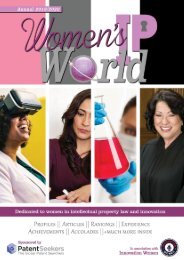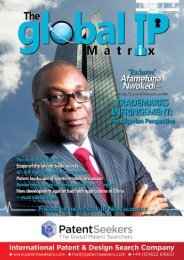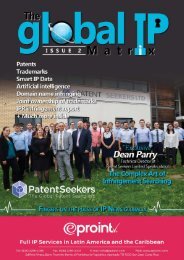Global IP Matrix - Issue 7
Dear readers, We sincerely hope that you are all in good health and keeping in good spirits during these undeniably uncertain times. We have all had to adapt to working out of our comfort zones, which I am sure has been very challenging at times for you all as it has been for us. However, we continue our quest to look to the future and deliver exclusive content to you, direct from thought leaders working at ground level in the IP industry from all over the world. Issue 7 of The Global IP Matrix magazine is packed with informative and exciting articles to keep you up to date and educated in what has been developing in the global IP industry during the past few months and into the future. We hope you enjoy reading our publication. We want to thank all our contributors for sharing their knowledge, opinions, and expertise in this new edition of the Global IP Matrix magazine. From all of us at The Global IP Matrix & Northon's Media, PR & Marketing Ltd
Dear readers,
We sincerely hope that you are all in good health and keeping in good spirits during these undeniably uncertain times. We have all had to adapt to working out of our comfort zones, which I am sure has been very challenging at times for you all as it has been for us.
However, we continue our quest to look to the future and deliver exclusive content to you, direct from thought leaders working at ground level in the IP industry from all over the world.
Issue 7 of The Global IP Matrix magazine is packed with informative and exciting articles to keep you up to date and educated in what has been developing in the global IP industry during the past few months and into the future. We hope you enjoy reading our publication.
We want to thank all our contributors for sharing their knowledge, opinions, and expertise in this new edition of the Global IP Matrix magazine.
From all of us at The Global IP Matrix & Northon's Media, PR & Marketing Ltd
You also want an ePaper? Increase the reach of your titles
YUMPU automatically turns print PDFs into web optimized ePapers that Google loves.
A hundred and forty years ago was when
Paris and Berne conventions were conceived
to shape the authors’ rights and industrial
property systems in an attempt to harness
the value of human creativity, unlike the ways
that the historical societies knew. At that time,
creativity was perceived as an extraordinary
activity achieved by the inspiration of a highly
gifted individual. Nowadays, most human
creativity is done as an everyday, mundane,
serial activity based on sheer knowledge,
which almost everyone in knowledge-based
societies performs. On top of that, intangible
assets created by harnessing and harvesting
humongous amounts of data by human and
machine efforts are becoming a form of an
asset as valuable as intellectual property and
energy ever were.
Human creativity and
development
This fundamental change has brought about
many unexpected metamorphoses of not only
how we create, but also how we understand
and apply the rules regulating human
creativity. Law grew complex to the border of
inherent inner contradictions, its original role
of providing guidance at odds with its growing
complexity, inconsistency, and slow pace of
its application. At the same time, complex
societies we are now living in are requiring
elevated complexity and flexibility in order to
be able to continue developing. By developing
in what can almost be described as a cancerous
growth, the law has become complex to the
degree that some social actors of change started
considering it more onerous then helpful.
The increase of the role of mediation as an
essentially non-legal dispute resolution method
is but one of the signs of this perception.
Organisations such as Commongood.org are
finding ways to push the social discourse into
examining the future role of the rule of law
in democratic societies. Most dangerously of
all, in many a country, the general population
started accepting the idea that introducing
non-democratic means of governance has
some advantages over democracies. To me,
it primarily means that law needs to be
streamlined to achieve the flexibility and
efficiency that it is now lacking.
Not only did creativity change. Forces of
globalisation, and not only globalisation in
the political sense, but primarily in logistical
and spiritual, have challenged the traditional
order impacting the central social principles
of sovereignty and territoriality. Of course,
the Berne and Paris IP order was based on
the traditional perceptions of territoriality,
specifically those prevailing in the nineteenth
century. Despite the recent backlash against
globalisation, our perception is that the
actual globalised integration is irrevocably
progressing in spite of the political setbacks. It
is the digital domain of the internet that made
the global connections a fact almost as hard
as, for example, the basis of the second law of
thermodynamics.
Its scientific concept of entropy teaches us
that, for example, a bottle of ink spilled into
a pool is physically impossible to recoup into
the bottle from which it was spilled.
It became challenging to imagine
how can any untangling of a global
population happen ever again,
barring some catastrophic collapse
of our civilisation. The planet has
truly become one, and territoriality
has become a burden in tackling
many problems, especially those
that are inherently global such as
environmental threats, and I would
add finding the best way to regulate
creativity. All of us in the intellectual
property field understand and
accept that creativity is the bestdistributed
resource of all. This is
why, after a hundred and fifty years,
we need to open up the dialogue
on what kind of system, legal or
otherwise, will extend the Paris and
Berne based intellectual property system that
served us so well for so long.
In order to be able to do this, we need to go back
and examine the constants and discontinuities
in the legal protection of creativity. This is best
done not only by legal but also through other
types of analysis that lawyers were traditionally
unwilling to conduct, such as semiotic analysis
of the language used to draft and construe the
rules and sociological and economic analysis of
the relations that are morphing in our societies
before our eyes.
Businesses have already noticed that keeping
the IP rights neatly boxed in their nineteenthcentury
compartments is not adequate for the
creativity that modern industries deploy in
developing their products. The same challenges
are visible to the artists who are dealing with the
issues of free expression since the emergence
of conceptual and pop art. This development
clearly pushes towards the merging of the
principles of copyright and freedom of speech
law. Shifts of this kind are why we have long
started speaking of overlapping intellectual
property rights and why our associations
moved from being dedicated to a single IP
right to all those related rights that we use to
protect the results stemming from the single
and singular human creative capability.
To a keen observer, it will sooner rather than
later become clear that it is always authors’
rights that will be first showing the inadequacies
and the direction in which the entire IP
universe will start changing. The accumulated
and mounting inadequacies and the inability
www.gipmatrix.com
to meaningfully reform the copyright world is
a clear sign of the difficulties the other Paris IP
worlds will face and an indication that the Paris
and Berne conventions are now confining such
meaningful change. It is dawning on the IP
professionals that the movement towards space
beyond the confines of the centuries-old IP
system has become desirable, if not inevitable.
A strong upsurge in creativity seems to be
closely followed by a proportional upsurge
of copying. As we all know, the onset of new
digital technologies in the copyright field has
led to a significant increase in unauthorised
copying. Once we digitise other formats of
human productivity and creativity, we will be
exposed to the similar growth of copying of
the objects of protection of other IP rights.
By now, it is becoming abundantly clear that
choosing law as a principal tool in combating
counterfeiting and piracy might not have been
the right choice. One could even assert that, in
light of the constant growth of counterfeiting
trade, choosing law as a principal tool in
combating counterfeiting was an inferior
choice and that the results might have been
different otherwise.
Challenges and
innovation
The challenge we are facing is that even those
lawyers who are thinking about innovation still
seem to believe that the innovation is confined
to introducing new legal services or products
and then finding novel ways to market them.
Not many seem to understand that lawyers
owe to their society innovations in managing
social relations in new ways as well. If we accept
that one of the basic tenets of contemporary
societies is innovation, and that innovation
must be pervasive in all social activity fields,
one starts wondering why the legal profession
would be excluded from it. Innovation cannot
remain a monopoly of a consumer or any
other industry in modern societies; all social
participants need to contribute by innovating.
Those lawyers who miss this will risk being
increasingly seen as a burden to their society.
While the text has no intention of proposing
strong conclusions on possible changes,
several theses emerge. Advancements are
likely to occur, but hard to anticipate as the
scope of social changes is also unprecedented,
and the nature of the digital medium is
radically dissimilar from analogue mechanical
reproduction means. Changes within the legal
system will not involve only copyright and other
rights of intangible human creativity results
protection, but an overall transformation of
the role of law within societies.
After an initial denial and a protracted period
of reluctance, the IP community seems to
have acknowledged that without seizing the
momentum, it might become marginalised in
the discussions on its own field of expertise.
It is, therefore, paramount for the IP, and
specifically trademark communities, to
leapfrog their reluctance in tackling these
complex issues.
(Mladen Vukmir is the Second Vice-President of
ECTA. Views in this text are entirely his own).
23












